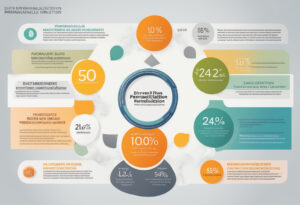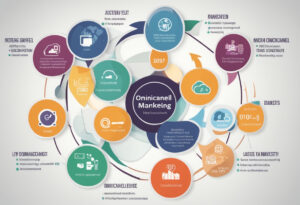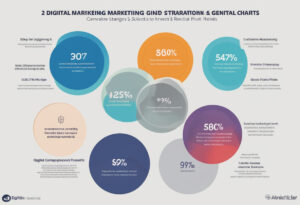7 Digital Marketing Strategies That Actually Generated ROI in 2025
7 Digital Marketing Strategies That Actually Generated ROI in 2025

7 Digital Marketing Strategies That Actually Generated ROI in 2025

Introduction
In today’s hyper-competitive digital landscape, implementing effective digital marketing strategies that deliver measurable returns on investment has become more crucial than ever. As we navigate through 2025, businesses are increasingly focusing on data-driven approaches that not only increase visibility but also drive conversions and sales. The “7 Digital Marketing Strategies That Actually Generated ROI in 2025″ represent proven tactics that forward-thinking companies have leveraged to achieve remarkable growth despite market saturation and evolving consumer behaviors.
These strategies reflect the latest technological advancements, shifting consumer preferences, and innovative approaches to digital engagement. What sets these approaches apart is their demonstrated ability to deliver tangible results, backed by comprehensive analytics and case studies from industry leaders. Whether you’re a startup looking to establish market presence or an established brand aiming to optimize your digital footprint, these strategies offer actionable insights that can transform your marketing effectiveness and maximize your return on investment.
Data-Driven Personalization at Scale

In 2025, the most successful marketers have moved beyond basic segmentation to implement sophisticated personalization systems that leverage artificial intelligence and predictive analytics. Companies achieving the highest ROI are using dynamic content systems that automatically adjust messaging, offers, and product recommendations based on real-time user behavior, historical interactions, and predictive modeling. These systems don’t just react to past behaviors but anticipate future needs and preferences with remarkable accuracy.
Case studies from leading e-commerce platforms reveal that implementing AI-driven personalization has resulted in conversion rate increases of 35-50% compared to traditional segmentation approaches. The key difference lies in the depth and specificity of personalization. While previous approaches might have personalized based on broad demographic categories, today’s high-ROI strategies personalize down to individual user journeys, taking into account micro-moments and contextual factors that influence purchasing decisions. Companies like Beauty Innovators saw a 43% increase in average order value after implementing AI-driven personalization across their product recommendation engine, email campaigns, and on-site messaging.
Implementation Best Practices
Successful implementation of data-driven personalization requires a strategic approach to data collection and utilization. Start by conducting a comprehensive audit of your existing customer data, identifying gaps that need to be filled to enable effective personalization. Develop a clear data governance framework that ensures compliance with privacy regulations while maximizing the utility of the data you collect.
When selecting personalization tools, prioritize platforms that offer seamless integration with your existing marketing stack and provide robust analytics capabilities. Begin with high-impact touchpoints such as product recommendations, email content, and landing pages before expanding to more complex personalization initiatives. Regularly test and refine your personalization algorithms to ensure they continue to deliver relevant experiences as consumer preferences evolve.
Measuring Personalization ROI
To accurately measure the ROI of your personalization efforts, establish clear baseline metrics before implementation. Track key performance indicators such as conversion rate, average order value, customer lifetime value, and engagement metrics across personalized versus non-personalized experiences. Advanced organizations are implementing sophisticated attribution models that can accurately assess the incremental impact of personalization on revenue and customer retention.
Remember that personalization ROI extends beyond immediate conversion metrics. Long-term benefits include increased customer loyalty, higher customer lifetime value, and improved brand perception. Companies like TechStyle Fashion Group have reported a 24% increase in customer retention rates and a 31% increase in repeat purchase frequency after implementing comprehensive personalization strategies across their digital touchpoints.
Integrated Omnichannel Marketing Ecosystems

The highest-performing digital marketing campaigns of 2025 have transcended the concept of multichannel marketing to create truly integrated omnichannel ecosystems. These ecosystems deliver seamless, consistent experiences across all customer touchpoints while maintaining contextual relevance for each platform. What distinguishes high-ROI omnichannel strategies is their ability to create synergistic effects where each channel amplifies the effectiveness of others rather than operating in isolation.
Leading brands have implemented sophisticated cross-channel attribution models that enable them to understand how different channels interact throughout the customer journey. This has allowed for more efficient allocation of marketing budgets and optimization of channel mix based on actual performance data rather than channel-specific metrics. For example, Global Retail Innovators increased their marketing ROI by 32% by optimizing their channel mix based on integrated attribution insights, reducing spend on underperforming channels while increasing investment in high-impact touchpoints.
Channel Synchronization Techniques
Effective omnichannel marketing requires precise coordination across platforms. The most successful companies are using centralized marketing hubs that serve as the command center for all campaign activities. These hubs enable real-time adjustment of messaging and offers based on customer interactions across channels, ensuring that all touchpoints reflect the most current and relevant information.
Advanced matching algorithms now allow marketers to maintain consistent customer identity across previously disparate channels. This identity resolution capability has proven critical for delivering coherent experiences regardless of where and how customers choose to engage. Implementing robust customer data platforms (CDPs) that unify customer profiles across channels has become a foundational element of high-ROI marketing strategies in 2025.
Cross-Channel Customer Journey Orchestration
Beyond basic channel coordination, top-performing companies are implementing sophisticated journey orchestration systems that intelligently guide customers through optimized paths to conversion. These systems use real-time decisioning engines to determine the next best action for each customer based on their behavior and preferences, dynamically adjusting the journey to maximize engagement and conversion probability.
The ROI impact of effective journey orchestration has been substantial. Wellness Direct experienced a 47% increase in campaign conversion rates after implementing cross-channel journey orchestration, with particularly strong results for complex purchase decisions requiring multiple touchpoints. Their approach enabled them to identify critical moments in the customer journey where targeted interventions could significantly impact purchase decisions.
Measurement and Optimization Framework
To maximize ROI from omnichannel marketing, leading companies have developed comprehensive measurement frameworks that capture both channel-specific and cross-channel performance metrics. These frameworks incorporate traditional KPIs such as conversion rates and engagement metrics while also measuring journey completion rates, cross-channel attribution, and overall experience consistency.
Regular journey analytics sessions bring together cross-functional teams to identify bottlenecks and optimization opportunities throughout the customer journey. This collaborative approach ensures that insights from direct customer feedback, quantitative analytics, and qualitative research inform continuous improvement of the omnichannel experience. Technology Services Group implemented this approach and achieved a 38% improvement in journey completion rates and a 29% increase in average order value within six months.
AI-Powered Content Generation and Optimization

Content marketing has undergone a revolutionary transformation in 2025, with AI-powered content generation and optimization emerging as a key driver of marketing ROI. Advanced natural language processing technologies have evolved to create high-quality, engaging content that resonates with target audiences while significantly reducing production costs and accelerating content creation timelines. The most successful companies are leveraging these tools not to replace human creativity but to augment it, focusing human resources on strategic direction while allowing AI to handle execution at scale.
The ROI impact of AI-content approaches has been substantial, with organizations reporting content production efficiency improvements of 300-500% while maintaining or improving engagement metrics. Financial Tech Innovators implemented AI-assisted content creation for their educational blog and saw a 215% increase in organic traffic within six months, coupled with a 43% reduction in content production costs. The key to their success was developing a strategic framework for AI collaboration that maintained brand voice and subject matter expertise while leveraging AI for research, drafting, and optimization.
Strategic Content Intelligence Systems
Beyond basic content generation, leading organizations have implemented comprehensive content intelligence systems that continuously analyze content performance across channels and provide actionable recommendations for improvement. These systems incorporate competitive analysis, audience intent modeling, and performance prediction to guide content creation and distribution decisions.
Content intelligence platforms now feature advanced predictive capabilities that forecast how specific content pieces will perform with different audience segments before publication. This predictive approach has dramatically improved content ROI by ensuring resources are allocated to content with the highest probability of driving business results. Media conglomerate Global Publishing Partners increased their content ROI by 67% after implementing predictive content intelligence, focusing their efforts on topics and formats with the highest projected engagement and conversion potential.
Dynamic Content Optimization
The most sophisticated content marketing approaches in 2025 incorporate real-time optimization capabilities that automatically adjust content elements based on performance data and user interactions. These systems can modify headlines, visuals, call-to-action elements, and even substantive content to maximize relevance and engagement for different audience segments.
A/B testing has evolved into multivariate testing at scale, with AI systems capable of testing dozens of content variations simultaneously and implementing winning versions automatically. This approach has dramatically accelerated the optimization cycle, allowing marketers to achieve peak content performance in days rather than weeks or months. E-learning platform Educational Frontiers increased their content conversion rates by 53% after implementing dynamic content optimization across their digital properties.
Content Distribution Intelligence
Even the most compelling content fails to generate ROI if it doesn’t reach the right audience through the right channels. High-performing organizations are now using AI-powered distribution intelligence to determine optimal syndication strategies for each content piece. These systems analyze historical performance data, current channel conditions, and competitive positioning to recommend the most effective distribution approach.
Distribution intelligence platforms incorporate sophisticated timing algorithms that identify the optimal publication schedule for different content types and channels. By synchronizing content distribution with periods of peak audience receptivity, organizations have significantly improved engagement metrics and conversion rates. Health and wellness brand Vitality Collective increased their content engagement rates by 41% and conversion rates by 37% after implementing AI-driven distribution intelligence, without increasing their content promotion budget.
Privacy-Centric Data Activation Strategies
In 2025, the most successful digital marketers have fully adapted to the post-cookie reality, developing sophisticated approaches that balance personalization with privacy compliance. Rather than viewing privacy regulations as limitations, these organizations have transformed their data practices to build trust while maintaining marketing effectiveness. Privacy-centric data activation has emerged as a critical differentiator, with companies that excel in this area achieving 40-60% higher customer acquisition and retention rates compared to those struggling with privacy adaptation.
The fundamental shift has been from third-party data dependence to first-party data excellence. Organizations generating the highest marketing ROI have invested in comprehensive first-party data infrastructures that capture valuable customer insights through direct interactions. These systems are built on a foundation of transparent value exchange, where customers willingly share information in return for enhanced experiences, personalized recommendations, and exclusive benefits. Consumer goods leader Household Essentials increased their marketing ROI by 47% after transitioning to a first-party data strategy, while simultaneously increasing their Net Promoter Score by 18 points due to improved privacy practices.
Zero-Party Data Collection Frameworks
Beyond first-party data, leading organizations have developed sophisticated zero-party data collection frameworks that directly engage customers in preference specification. These frameworks utilize interactive experiences such as preference centers, style quizzes, product configurators, and guided shopping experiences to gather explicit preference data that drives highly relevant marketing.
The key innovation in zero-party data collection has been making the process engaging and valuable rather than transactional. Companies achieving the highest ROI have transformed data collection into experiences that customers actively seek out rather than tolerate. Fashion retailer Style Frontiers generated a 53% increase in conversion rates for customers who engaged with their style preference experience compared to non-participants, with 78% of customers voluntarily completing the full preference specification process.
Contextual Targeting Renaissance
As identity-based targeting has become more challenging, sophisticated contextual targeting has reemerged as a powerful strategy for reaching relevant audiences without relying on personal identifiers. Advanced contextual intelligence platforms now incorporate natural language processing, image recognition, and sentiment analysis to develop a nuanced understanding of content and context.
The most effective contextual targeting approaches go beyond basic keyword matching to analyze semantic relationships, user intent signals, and content quality indicators. This sophisticated contextual understanding enables precise alignment between marketing messages and relevant content environments. B2B technology provider Enterprise Solutions increased their advertising ROI by 62% after implementing advanced contextual targeting, achieving higher conversion rates than their previous audience targeting approach while eliminating privacy concerns.
Federated Learning Implementation
On the cutting edge of privacy-centric marketing, leading organizations have begun implementing federated learning technologies that enable pattern recognition and predictive modeling without centralizing sensitive user data. These approaches process data on local devices or environments, sharing only anonymized insights rather than raw data.
Federated learning has shown particular promise for predictive analytics applications where traditional approaches would require extensive personal data collection. By keeping sensitive information local while still benefiting from collective intelligence, these systems maintain marketing effectiveness while significantly reducing privacy risks. Healthcare marketer Wellness Partners implemented federated learning for their condition-specific marketing initiatives and increased campaign performance by 34% while maintaining full compliance with stringent healthcare privacy regulations.
Immersive Experience Marketing

The evolution of digital experiences has reached new heights in 2025, with immersive technologies transitioning from experimental initiatives to core drivers of marketing ROI. Virtual reality, augmented reality, mixed reality, and spatial computing have matured into practical marketing channels that deliver measurable business results. Companies leveraging these technologies effectively have reported conversion rate increases of 70-120% for products and services marketed through immersive experiences compared to traditional digital channels.
What distinguishes high-ROI immersive marketing from earlier attempts is the seamless integration of these experiences into the broader customer journey. Rather than standalone novelties, today’s successful immersive experiences serve specific strategic purposes within the marketing funnel, whether building awareness, enabling product exploration, or facilitating purchase decisions. Furniture retailer Living Spaces increased their e-commerce conversion rates by 78% and reduced return rates by 43% after implementing an AR-based visualization tool that allows customers to accurately preview products in their own homes.
Virtual Product Experiences
Product visualization and virtual trial capabilities have emerged as particularly high-ROI applications of immersive technology. Advanced virtual product experiences now feature photorealistic rendering, accurate physics simulation, and contextual placement capabilities that give customers confidence in their purchase decisions without physical interaction with products.
The sophistication of these experiences has increased dramatically, with sensory feedback, spatial audio, and environmental factors creating increasingly convincing simulations. Automotive manufacturer Luxury Motors reported that customers who engaged with their immersive vehicle configurator spent 67% more time exploring options and selected 34% more premium features compared to their traditional online configurator, resulting in a 23% increase in average order value.
Spatial Commerce Environments
Beyond single-product visualization, leading brands have created comprehensive spatial commerce environments that reimagine the shopping experience. These virtual retail spaces combine the convenience of e-commerce with the experiential aspects of physical retail, allowing customers to navigate intuitively designed environments that showcase products in context and facilitate discovery.
The most effective spatial commerce implementations incorporate social elements that enable shared shopping experiences among friends or with virtual shopping assistants. This social dimension has proven particularly valuable for products where input from others influences purchase decisions. Fashion retailer Style Collective launched a virtual flagship store that allows friends to shop together remotely and experienced a 92% increase in conversion rates for customers who participated in social shopping sessions.
Measuring Immersive Marketing ROI
As immersive marketing has matured, so have the methodologies for measuring its effectiveness. Leading organizations have developed comprehensive measurement frameworks that track traditional conversion metrics alongside immersive-specific indicators such as spatial engagement patterns, interaction depth, and emotional response markers.
Advanced eye-tracking and attention metrics now provide granular insight into how users engage with immersive content, enabling continuous optimization of these experiences. By identifying which elements draw attention, create emotional responses, or trigger decision points, marketers can systematically improve the performance of immersive experiences. Luxury brand Exclusive Experiences implemented spatial analytics for their virtual showroom and increased conversion rates by 47% after optimizing their environment based on engagement pattern insights.
Hyper-Automated Campaign Orchestration

The most efficient digital marketing organizations of 2025 have embraced comprehensive automation across the marketing function, implementing sophisticated orchestration systems that manage campaigns with minimal human intervention. These systems don’t simply automate individual tasks but orchestrate end-to-end campaigns that continuously optimize based on performance data and changing market conditions. Companies that have successfully implemented hyper-automated campaign orchestration report efficiency improvements of 200-300% and performance improvements of 30-50% compared to traditional campaign management approaches.
What separates high-ROI automation from basic automation is the depth of intelligence embedded in these systems. Today’s advanced platforms incorporate predictive analytics, machine learning, and generative AI to make sophisticated decisions about audience targeting, channel selection, creative optimization, budget allocation, and timing. Software company Enterprise Solutions increased their marketing ROI by 68% after implementing hyper-automated campaign orchestration across their demand generation programs, reducing campaign launch time from weeks to hours while significantly improving performance metrics.
Autonomous Budget Optimization
One of the most impactful applications of automation has been in real-time budget allocation and optimization. Advanced systems now continuously reallocate marketing investments across channels, campaigns, and audience segments based on performance data, competitive intelligence, and conversion probability models. This dynamic approach ensures that marketing resources flow to the highest-performing opportunities without manual intervention.
The most sophisticated budget optimization systems incorporate predictive elements that anticipate performance changes before they occur, proactively shifting investments to maximize returns. These systems can identify early signals of declining performance or emerging opportunities and adjust budgets accordingly. E-commerce platform Shopping Innovators increased their marketing ROI by 42% after implementing autonomous budget optimization across their digital channels, with particularly strong results during high-volatility shopping periods like holiday seasons.
Creative Performance Intelligence
Beyond campaign and budget automation, leading organizations have implemented creative performance intelligence systems that automatically evaluate and optimize marketing creative. These systems analyze vast amounts of performance data to identify patterns and correlations between creative elements and business outcomes, generating actionable insights that drive continuous improvement.
Creative intelligence platforms now incorporate advanced computer vision and natural language processing capabilities that can deconstruct ads into their component elements and assess the contribution of each element to overall performance. This granular understanding enables marketers to systematically improve creative effectiveness based on empirical data rather than subjective assessments. Media agency Creative Collective increased client campaign performance by 51% after implementing creative performance intelligence across their digital advertising programs.
Algorithmic Audience Expansion
Traditional audience targeting approaches have been revolutionized by algorithmic audience expansion systems that continuously discover and activate new high-value segments. These systems analyze patterns within existing high-performing audiences to identify similar prospects who may have been overlooked by conventional targeting strategies.
The most effective audience expansion algorithms incorporate multiple data dimensions beyond basic demographics and behaviors, including contextual factors, intent signals, and propensity modeling. This multidimensional approach results in higher-quality prospect identification and more efficient customer acquisition. Financial services company Wealth Innovators reduced their customer acquisition costs by 38% while increasing conversion quality after implementing algorithmic audience expansion across their prospecting campaigns.
Voice and Conversational Commerce Optimization

As voice interfaces and conversational AI have become mainstream interaction channels, forward-thinking organizations have developed sophisticated voice commerce strategies that deliver significant ROI. The voice commerce market has expanded dramatically in 2025, with voice-initiated transactions accounting for a growing share of digital commerce revenue. Companies that have successfully optimized for voice and conversational commerce report conversion rate improvements of 45-65% compared to traditional digital channels for compatible product categories.
The key insight driving high-ROI voice commerce strategies is understanding that voice represents a fundamentally different interaction paradigm rather than simply a new channel for existing approaches. Successful organizations have reimagined their customer journeys, product discovery experiences, and conversion paths specifically for conversational contexts. Grocery retailer Fresh Direct increased their voice commerce revenue by 83% after implementing a conversational shopping assistant optimized for replenishment purchases, capturing a significant share of routine household restocking transactions.
Voice Search Optimization Techniques
As voice search has evolved from a novelty to a primary discovery method for many consumers, leading organizations have developed comprehensive voice search optimization strategies. These approaches go beyond basic keyword optimization to address the unique characteristics of voice queries, including natural language patterns, question formats, and conversational context.
The most effective voice search strategies incorporate semantic search optimization, structured data implementation, and conversational content development. This multifaceted approach ensures visibility across voice platforms and maximizes the probability of being selected as the definitive answer for relevant queries. Home services provider Reliable Solutions increased their voice-driven lead volume by 74% after implementing a comprehensive voice search optimization strategy focused on common household problem scenarios.
Conversational Commerce Pathways
Beyond search visibility, leading organizations have developed streamlined conversational commerce pathways that facilitate transactions within voice environments. These pathways minimize friction by leveraging saved payment information, simplified product selection processes, and contextual recommendations tailored to voice interaction constraints.
The most sophisticated conversational commerce implementations incorporate memory elements that maintain context across interactions, enabling natural conversation flows that span multiple sessions. This persistent context creates a more intuitive experience that builds familiarity and trust over time. Beauty retailer Glamour Direct increased their voice commerce conversion rates by 58% after implementing a conversational replenishment pathway that recalls customer preferences and purchase history to streamline reordering.
Voice Analytics and Optimization
As with any high-performing marketing channel, sophisticated analytics capabilities have proven essential for optimizing voice commerce performance. Leading organizations have implemented comprehensive voice analytics platforms that provide insight into conversation patterns, intent recognition accuracy, abandonment points, and conversion factors.
These analytics systems enable systematic optimization of conversational flows based on empirical data rather than assumptions about user behavior. By identifying common friction points, successful intent patterns, and effective recommendation approaches, marketers can continuously improve voice commerce performance. Electronics retailer Tech Direct increased their voice assistant conversion rates by 47% after implementing voice analytics and optimizing their conversation flows based on pattern recognition insights.
Conclusion

The digital marketing landscape of 2025 has been shaped by unprecedented technological advancement, evolving consumer expectations, and an increasingly competitive marketplace. The seven strategies outlined in this article represent the approaches that have generated the most significant returns on investment for forward-thinking organizations. What unites these strategies is their data-driven foundation, customer-centric orientation, and adaptive execution.
As we look ahead, it’s clear that digital marketing success will continue to require both technological sophistication and deep human insight. The organizations achieving the highest ROI are not those blindly adopting every new technology but those thoughtfully implementing solutions that address specific business challenges and customer needs. By focusing on the strategies that have demonstrated measurable returns – data-driven personalization, integrated omnichannel ecosystems, AI-powered content, privacy-centric data activation, immersive experiences, hyper-automated orchestration, and voice commerce optimization – marketers can position themselves for success in an increasingly complex digital landscape.
The future of digital marketing belongs to organizations that can balance innovation with execution excellence, leveraging cutting-edge capabilities while maintaining unwavering focus on creating value for customers and driving business results. By learning from the proven strategies that have generated ROI in 2025, marketers can develop approaches that will continue to deliver returns as the digital ecosystem evolves.